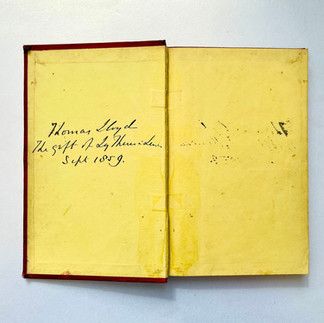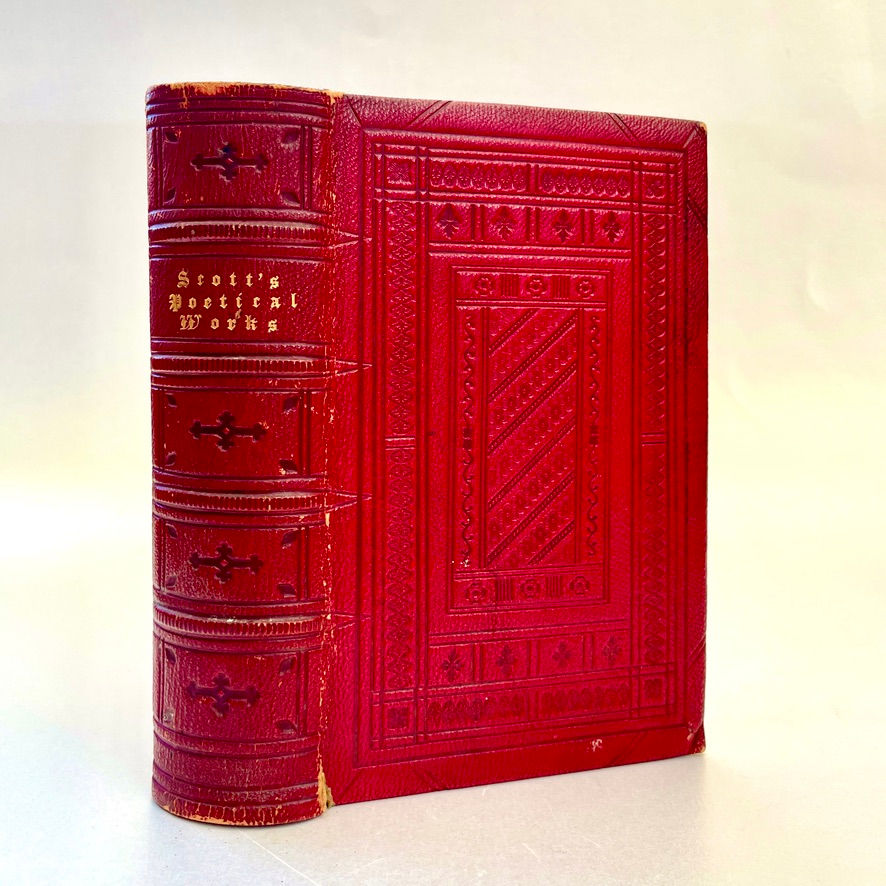When Stories Are Found in Inscriptions: Following Provenance in Antiquarian Books
- Marie
- Aug 3
- 3 min read
Updated: Aug 4
There is something quietly powerful about finding a handwritten inscription in an old book. In my work with antiquarian books, I spend a lot of time looking closely at these kinds of details. A name, a date, or even a faint scrawl can offer a window into the past. These are often the starting points of deeper stories, and sometimes they lead somewhere completely unexpected.
This was exactly what happened with a beautifully bound 1855 edition of Natural Phenomena, published by the Society for Promoting Christian Knowledge in London. From the outside, the book already stood out. But what I discovered inside gave it a new level of significance.
Tracing an Inscription in Natural Phenomena (1855)
This mid-Victorian volume is bound in richly decorated red cloth with gilt titles and botanical motifs. Inside are over 50 illustrations covering a range of natural subjects, from rainbows and auroras to volcanoes and glaciers. It is a charming example of Victorian educational publishing, but it was the handwritten inscription that caught my attention.
It reads:
“Thomas Lloyd. The gift of Ly Theresa Lewis. September 1859.”
At first, the final part of the name was difficult to read. I knew it would be worth investigating. This is the kind of research I enjoy most, looking at the handwriting closely, trying to identify the individuals involved, and piecing together the story behind the gift. I started with my usual process, using a combination of visual examination, historical research, and online tools.
Researching Inscriptions in Antiquarian Books
I always begin by examining the handwriting in detail. I try to understand the flow and style before I turn to digital resources. Once I have a working theory, I explore archive materials, genealogical records, and old publications. Occasionally, if a name or abbreviation is unclear, I use AI tools to help generate possibilities.
In this case, the AI correctly interpreted "Ly" as short for Lady. That alone gave me a good lead. However, it offered a completely incorrect surname. I explored variations, but nothing was fitting. I kept returning to the inscription, convinced I was missing something obvious.
That final check was what made the difference.
Discovering Lady Theresa Lewis
After another look at the handwriting, I saw it clearly. The surname was Lewis. Once I searched for Lady Theresa Lewis, everything began to fall into place.
Maria Theresa Lewis, born Villiers, was a respected writer and editor married to Sir George Cornewall Lewis. She was part of the mid-nineteenth-century literary world, publishing and editing titles such as The Lives of the Friends and Contemporaries of Lord Chancellor Clarendon and The Semi-Detached House by Emily Eden. That particular book was published in 1859, the same year as the inscription in this copy of Natural Phenomena.
The best part was the handwriting match. I found a documented example where Lady Theresa Lewis wrote the year 1859, and the script was strikingly similar. The way she formed her numbers and shaped her letters was almost identical. That kind of evidence adds a great deal of confidence to the attribution.
Why Provenance Research in Antiquarian Books Matters
Uncovering provenance in antiquarian books gives them a deeper sense of meaning. It helps us connect the physical object to its personal history. This particular copy of Natural Phenomena is no longer just a beautifully illustrated Victorian book. It is also a piece of documented literary history, carrying the signature of a known figure in the mid-Victorian cultural world.
This kind of research transforms the book. It connects it to real people and their lives, giving it value not just for collectors but for anyone interested in the literary and social history of the period.
Why Inscriptions Deserve a Second Look
It would have been easy to skim past the inscription, especially with the handwriting being unclear. But this is a reminder that it often takes a second or third look to see what is really there. A single handwritten name can unlock an entire historical context. In this case, it led to a woman active in one of the most fascinating literary periods of the nineteenth century.
Final Thoughts
This 1855 edition of Natural Phenomena is now available in my collection. Its charm lies not only in the beautiful illustrations and decorative binding, but also in the story behind the inscription. This is exactly why I love working with old books. These discoveries do not happen every time, but when they do, they turn a simple volume into a piece of literary history.
If you collect or sell antiquarian books, or even just enjoy the feel of a well-made Victorian volume, take time to look at the inscriptions. They often hold more than just a name. They hold stories that are still waiting to be found.
Find this book at https://www.literarytreasures.co.uk/product-page/1855-natural-phenomena-rare-victorian-science-book-gift-of-lady-theresa-lewis










Comments